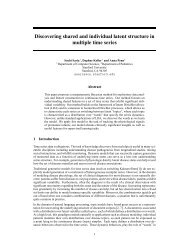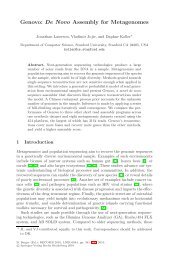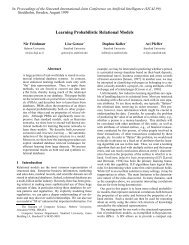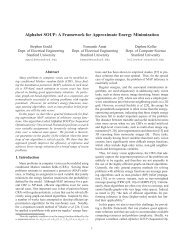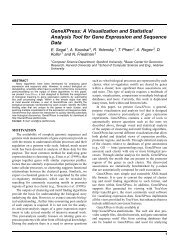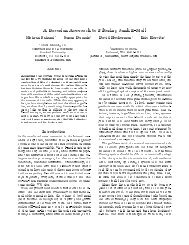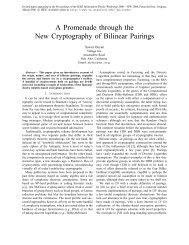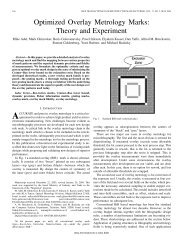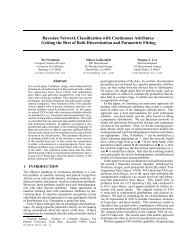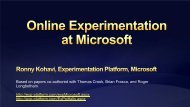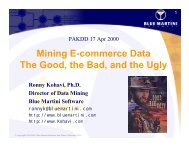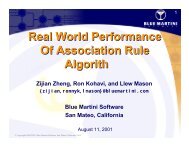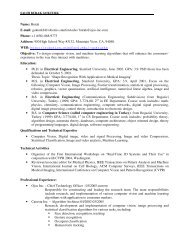Region-based Segmentation and Object Detection - Stanford ...
Region-based Segmentation and Object Detection - Stanford ...
Region-based Segmentation and Object Detection - Stanford ...
You also want an ePaper? Increase the reach of your titles
YUMPU automatically turns print PDFs into web optimized ePapers that Google loves.
4 Inference <strong>and</strong> Learning<br />
We now describe how we perform inference <strong>and</strong> learn the parameters of our energy function.<br />
4.1 Inference<br />
We use a modified version of the hill-climbing inference algorithm described in Gould et al. [7],<br />
which uses multiple over-segmentations to propose large moves in the energy space. An overview<br />
of this procedure is shown in the right of Figure 1. We initialize the scene by segmenting the<br />
image using an off-the-shelf unsupervised segmentation algorithm (in our experiments we use meanshift<br />
[3]). We then run inference using a two-phased approach.<br />
In the first phase, we want to build up a good set of initial regions before trying to classify them as<br />
objects. Thus we remove the object variables O <strong>and</strong> C from the model <strong>and</strong> artificially increase the<br />
boundary term weights (η bdry<br />
α <strong>and</strong> η bdry<br />
A ) to promote merging. In this phase, the algorithm behaves<br />
exactly as in [7] by iteratively proposing re-assignments of pixels to regions (variables R) <strong>and</strong> recomputes<br />
the optimal assignment to the remaining variables (S <strong>and</strong> vhz ). If the overall energy for the<br />
new configuration is lower, the move is accepted, otherwise the previous configuration is restored<br />
<strong>and</strong> the algorithm proposes a different move. The algorithm proceeds until no further reduction in<br />
energy can be found after exhausting all proposal moves from a pre-defined set (see Section 4.2).<br />
In the second phase, we anneal the boundary term weights <strong>and</strong> introduce object variables over<br />
all foreground regions. We then iteratively propose merges <strong>and</strong> splits of objects (variables O) as<br />
well as high-level proposals (see Section 4.2 below) of new regions generated from sliding-window<br />
object c<strong>and</strong>idates (affecting both R <strong>and</strong> O). After a move is proposed, we recompute the optimal<br />
assignment to the remaining variables (S, C <strong>and</strong> vhz ). Again, this process repeats until the energy<br />
cannot be reduced by any of the proposal moves.<br />
Since only part of the scene is changing during any iteration we only need to recompute the<br />
features <strong>and</strong> energy terms for the regions affected by a move. However, inference is still slow given<br />
the sophisticated features that need to be computed <strong>and</strong> the large number of moves considered.<br />
To improve running time, we leave the context terms ψctxt out of the model until the last iteration<br />
through the proposal moves. This allows us to maximize each region term independently during<br />
each proposal step—we use an iterated conditional modes (ICM) update to optimize vhz after the<br />
region labels have been inferred. After introducing the context term, we use max-product belief<br />
propagation to infer the optimal joint assignment to S <strong>and</strong> C. Using this approach we can process<br />
an image in under five minutes.<br />
4.2 Proposal Moves<br />
We now describe the set of pixel <strong>and</strong> region proposal moves considered by our algorithm. These<br />
moves are relative to the current best scene decomposition <strong>and</strong> are designed to take large steps in<br />
the energy space to avoid local minima. As discussed above, each move is accepted if it results in a<br />
lower overall energy after inferring the optimal assignment for the remaining variables.<br />
The main set of pixel moves are described in [7] but briefly repeated here for completeness.<br />
The most basic move is to merge two adjacent regions. More sophisticated moves involve local<br />
re-assignment of pixels to neighboring regions. These moves are proposed from a pre-computed<br />
dictionary of image segments Ω. The dictionary is generated by varying the parameters of an unsupervised<br />
over-segmentation algorithm (in our case mean-shift [3]) <strong>and</strong> adding each segment ω to<br />
the dictionary. During inference, these segments are used to propose a re-assignment of all pixels<br />
in the segment to a neighboring region or creation of new region. These bottom-up proposal moves<br />
work well for background classes, but tend to result in over-segmented foreground classes which<br />
have heterogeneous appearance, for example, one would not expect the wheels <strong>and</strong> body of a car to<br />
be grouped together by a bottom-up approach.<br />
An analogous set of moves can be used for merging two adjacent objects or assigning regions<br />
to objects. However, if an object is decomposed into multiple regions, this bottom-up approach is<br />
problematic as multiple such moves may be required to produce a complete object. When performed<br />
independently, these moves are unlikely to improve the energy. We get around this difficulty by<br />
introducing a new set of powerful top-down proposal moves <strong>based</strong> on object detection c<strong>and</strong>idates.<br />
Here we use pre-computed c<strong>and</strong>idates from a sliding-window detector to propose new foreground<br />
regions with corresponding object variable. Instead of proposing the entire bounding-box from the<br />
detector, we propose the set of intersecting segments (from our segmentation dictionary Ω) that are<br />
fully contained within the bounding-box in a single move.<br />
6




